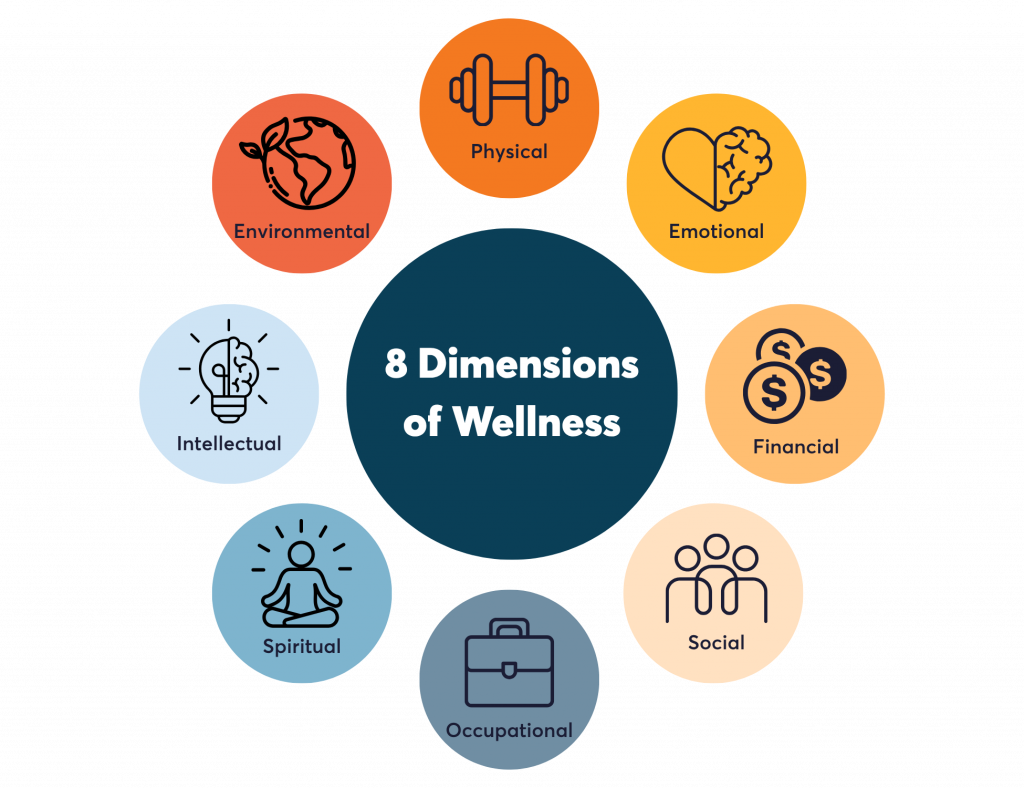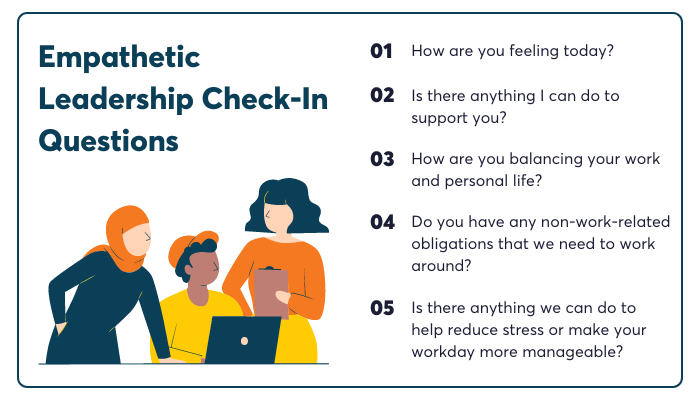Short on time? Here are the key takeaways:
- Well-being is multidimensional, encompassing physical, emotional, social, financial, occupational, intellectual, spiritual, and environmental aspects.
- Prioritizing holistic employee well-being leads to higher engagement, satisfaction, and organizational performance.
- Initiatives that span the dimensions of wellness, such as flexible work policies, mental health support, and professional development, are vital for meeting diverse employee needs.
- Investing in employee wellness programs delivers long-term benefits, including reduced burnout, increased retention, and improved workplace culture.
Work and life are not mutually exclusive—what happens on the job impacts employees’ personal lives, and vice versa. Creating an environment that holistically supports employee well-being drives higher engagement, productivity, and motivation across the organization. By embracing dimensions beyond the physical, such as mental, social, financial, occupational, and intellectual wellness, organizations can help employees experience greater life satisfaction, improved focus, and a deeper sense of fulfillment at work.
What Is Well-Being?
Well-being is a state of being healthy, happy, and comfortable both physically and mentally. It reflects how individuals perceive their lives, including their sense of purpose, balance, stability, and relationship quality. Employee well-being extends these dimensions to the workplace, reflecting how individuals feel and function professionally.
What Are the Eight Dimensions of Well-Being?

- Physical: Maintaining health through regular exercise, proper nutrition, adequate sleep, and routine medical check-ups. Physical well-being involves taking proactive steps to prevent illness and manage existing conditions.
- Emotional: Improving emotional health, psychological stability, and the ability to cope with stress. Mental well-being includes managing emotions, maintaining a positive outlook, building resilience, and seeking help when needed.
- Social: Building and maintaining high-quality relationships with others. Social well-being involves having a reliable network of friends, family, and colleagues, along with a strong sense of belonging, support, and connection.
- Financial: Feeling secure and confident about one’s financial situation. Financial well-being includes managing money effectively, planning for the future, and being able to handle unexpected expenses.
- Occupational: Having a fulfilling and meaningful career. Occupational well-being involves job satisfaction, career growth, work-life balance, and alignment between one’s role, personal values, and goals.
- Intellectual: Engaging in lifelong learning, creative pursuits, and critical thinking to stimulate the mind. Intellectual well-being involves seeking out new knowledge, embracing curiosity, staying mentally active, and being open to new ideas and perspectives.
- Spiritual: Finding purpose, meaning, and alignment between personal values and life choices. Spiritual well-being is about feeling connected to something greater than oneself, whether through religion, nature, personal reflection, or community service.
- Environmental: Creating and sustaining healthy surroundings that support well-being and reflect respect for the planet. Environmental well-being includes maintaining safe, clean, and organized spaces (e.g., at home, at work, in the community) as well as being mindful of one’s ecological impact.
Steps for Improving Employee Well-Being in Your Workplace
Given its multifaced nature, addressing all aspects of employee well-being in the workplace can be daunting. Beginning with the following core principles establishes a strong foundation for enhancing employee health, quality of life, and job satisfaction.
1. Encourage Physical Activity

Physical activity is often the first aspect people associate with well-being. Regular exercise prevents chronic diseases, improves cardiovascular health, and combats depression. This reduces absenteeism and healthcare costs, keeping employees healthier and more present at work. To encourage physical activity among your workforce, consider the following:
- Movement-friendly spaces: Design office layouts with features like standing desks, accessible stairs, and designated areas for stretching and light exercises to promote daily physical activity. Ensure these spaces are convenient and inviting to encourage employees to incorporate movement into their workday.
- Exercise incentives: Provide motivating rewards such as gym membership discounts, fitness-related gift cards, or extra time off for meeting exercise goals. Recognize and reward consistent participation in physical activities to encourage ongoing engagement and commitment.
- Fitness challenges: Launch competitions like step challenges or team-based fitness goals to make exercise engaging and fun. Track progress, offer prizes for top achievers, and foster a sense of community to inspire employees to stay active and participate together.
2. Cultivate Purpose

When employees find meaning in their work and see how their contributions align with the company’s mission, they are more engaged, motivated, and happy with their jobs. Focus on the following to foster a sense of purpose:
- Professional development: Provide opportunities for growth, such as mentorship programs, workshops, and courses to help employees build their professional skills and cultivate intellectual wellness. Encourage regular career development discussions between managers and team members to set goals, identify paths for career advancement, and discuss challenges employees are facing. Managers should take an active interest in team members’ aspirations and guide them in achieving their objectives.
- Connection to the company’s purpose: Highlighting how an employee’s role contributes to the company’s purpose cultivates a deeper connection and commitment to their job. Clearly communicate organizational goals, articulating how everyone’s efforts contribute to them. By reinforcing the bigger picture, employees can feel like a part of something greater than themselves.
- Value-based living: Encourage employees to identify and reflect on their personal values and integrate them into daily tasks and long-term goals. This infuses fulfillment, authenticity, and intention into routines. Additionally, strive for an organizational culture that promotes ethical behavior, social responsibility, and a commitment to positive impact, which often align with personal beliefs.
- Environmental consciousness: Empower employees to take part in eco-conscious practices at work, such as reducing waste, conserving energy, and participating in sustainability initiatives (e.g., community clean-ups) that reinforce shared values and contribute to a healthier planet.
3. Prioritize Work-Life Balance

Many factors contribute to employees’ perception of a healthy work-life balance, such as adequate time for personal activities and responsibilities, autonomy to manage one’s schedule, and the ability to disconnect from work after hours. Individual circumstances (e.g., job roles, caregiving responsibilities, health needs), along with broader trends like the return-to-office (RTO) movement, can significantly impact these factors.
A one-size-fits-all approach to work policies often fails to maintain a healthy work-life balance for everyone. Instead, adopt a tailored approach to support each individual’s unique situation by focusing on:
- Flexible work arrangements: Preferences for flexibility can vary greatly among individuals. For example, working parents might benefit from flexible hours to manage childcare; employees with long commutes can save time by working remotely; and those in independent roles may be more productive with flexible work locations and schedules. Allowing employees to influence their work accommodations and openly discuss their needs with managers boosts job satisfaction, enhances productivity, and reduces stress.
- Ensuring manageable workloads: Overburdening employees with excessive tasks can lead to burnout. Promote ongoing communication between managers and employees to regularly assess and adjust workloads. This maintains productivity while protecting employee well-being.
- Time off policies: Encouraging employees to take regular breaks, use their vacation time, and disconnect after work hours ensures they’re properly rested and recharged. Unlimited paid time off (PTO) uses quality of work as a measure of success rather than time spent working, empowering employees to take necessary breaks. Disconnecting from work should be actively encouraged, not just accepted.
4. Provide Mental Health Support

Depression, anxiety, and other mental health issues are rising, affecting 1 in 5 adults and impacting their work and personal life. Providing mental health support in the workplace ensures that employees have the resources they need to manage challenges effectively, bring their best selves to work, and maintain a positive and resilient mindset. Supportive mental health initiatives can include:
- Counseling services: Employee assistance programs are staffed with social workers, psychologists, psychiatrists, and other mental health professionals who provide confidential counseling services. Offering on-site or virtual therapy options can make mental healthcare easily accessible and assist workers dealing with personal or work-related issues.
- Stress management initiatives: Stress management challenges and programs can help employees cope with stress through education and effective management techniques such as mindfulness practices. Additionally, many free or low-cost mobile app solutions can be recommended or offered to employees.
- Empathetic leadership: Managers should regularly check in with their team to support mental health. Practicing active listening, empathy, and understanding demonstrates genuine care for employees’ well-being. Managers can also share their own experiences with mental health to normalize conversations and reduce stigma.

5. Encourage Social Connections
Strong social connections at work create a sense of belonging, support, and trust. When employees have authentic relationships with colleagues, they feel more valued and understood, comfortable seeking and offering help, and confident overcoming workplace challenges collectively. To foster social wellness in the workplace, implement the following:
- Team-building activities: Organize activities that promote camaraderie, such as team lunches, group walks, or after-work socials. Some activities can overlap with other dimensions of well-being, like participating in a sports game to build teamwork and improve physical fitness. Team-building activities break down barriers, build trust, and improve communication among members.
- Mentorship programs: Pair employees with mentors who can provide guidance, support, and encouragement. Mentorship programs facilitate professional development while building strong relationships between employees at different levels of the organization. Encourage mentors and mentees to discuss personal topics, such as family, health, and career goals, to help employees feel supported in all aspects of their lives.
- Social events and clubs: Organize clubs centered around diverse interests, such as sports teams, book clubs, volunteer groups, or hobbies (e.g., gardening, cooking). Connecting employees through shared interests strengthens bonds outside of work tasks. Social events like company retreats can help employees become acquainted with each other on a personal level and further unite the organization.

6. Support Financial Wellness
Rising living costs, mounting debt, and broader economic uncertainties create financial stress for 68% of employees, contributing to anxiety and making it difficult to concentrate on day-to-day job responsibilities. Financial wellness programs and competitive compensation builds financial security, stability, and confidence, which translates into improved focus and performance at work.
To create long-term, sustainable changes in employees’ financial behaviors, one-off events (i.e., annual financial wellness seminars) are often insufficient. Financial well-being must be treated like any other dimension of wellness, with year-round resources and support to encourage healthy behaviors. This includes:
- Competitive compensation: Regularly review and adjust compensation packages to match industry standards and the cost of living. Pay transparency, which involves open communication about how salaries are determined and the potential for raises or bonuses, builds trust and shows employees that their financial well-being is valued.
- Employer-sponsored retirement plans: Offering 401(k) plans with matching contributions helps employees grow their savings over time. Automatically enrolling them as soon as they’re eligible lets them start building savings immediately without requiring any initial action.
- Financial education programs: Providing resources on budgeting, debt management, retirement planning, and investment strategies empowers employees with the knowledge to make informed financial decisions. Consider partnering with financial advisors to provide personalized advice and help employees develop financial plans based on unique needs and goals.

Conclusion
Employee wellness programs addressing multiple dimensions of well-being can improve employees’ quality of life and satisfaction, leading to a more positive and productive workplace. The return-on-investment (ROI) is substantial, with benefits including reduced absenteeism, lower healthcare costs, increased employee engagement, and improved performance. Overall, investing in employee well-being is a win-win strategy that supports individual fulfillment and organizational success.












